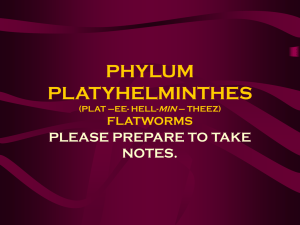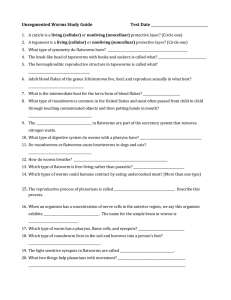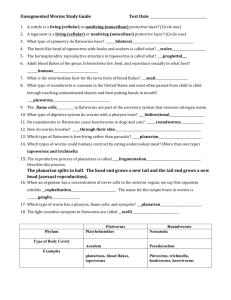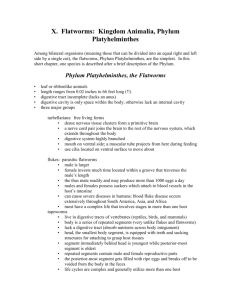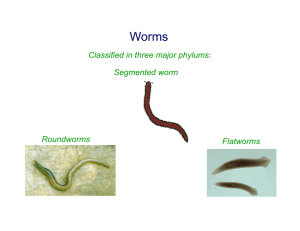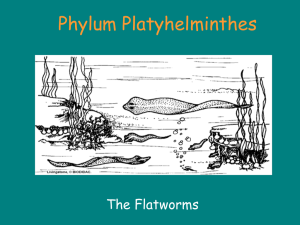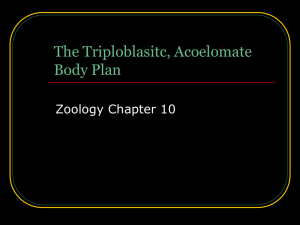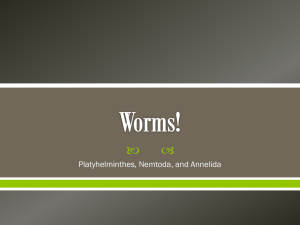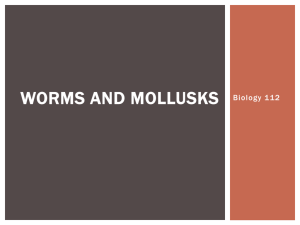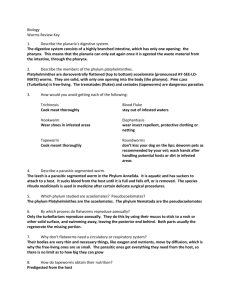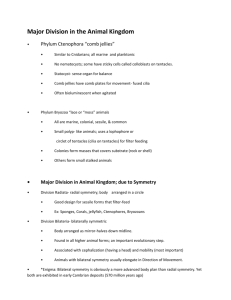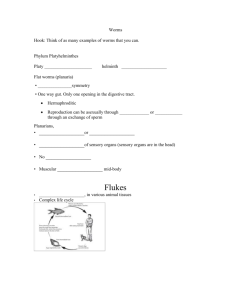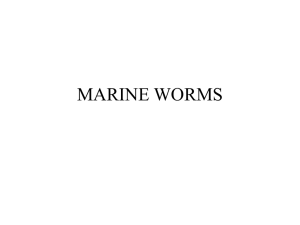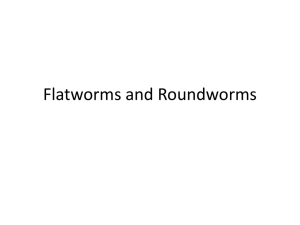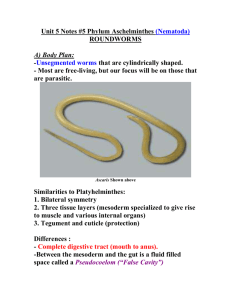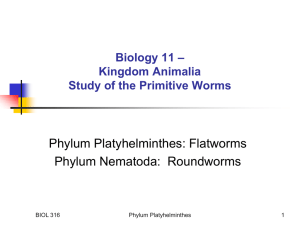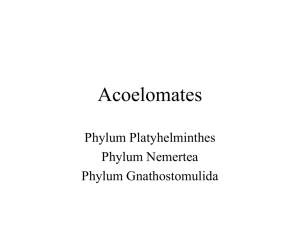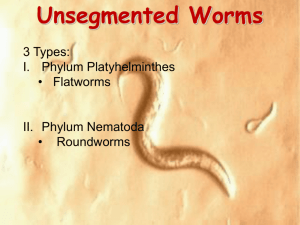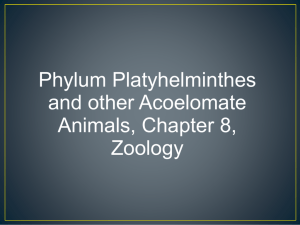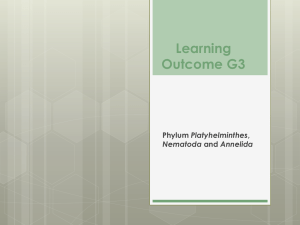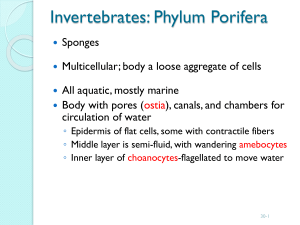worms - holyoke
advertisement
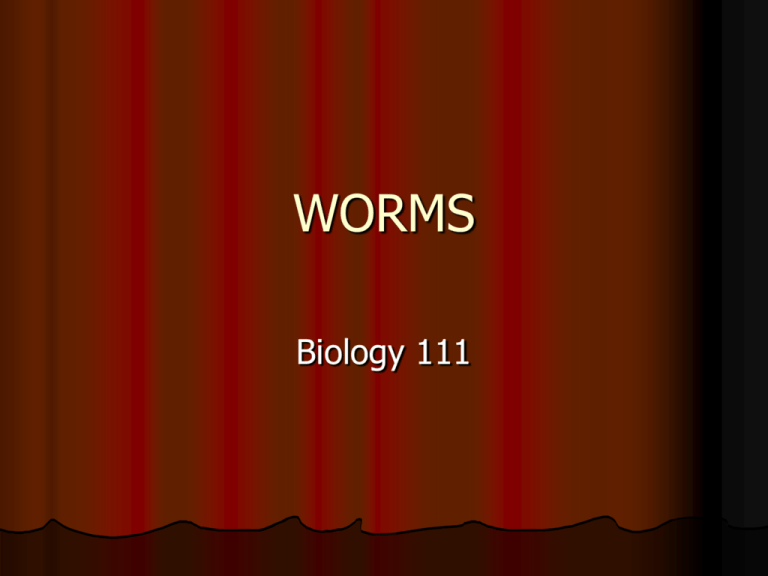
WORMS Biology 111 WORMS Over 20,000 wormlike organisms Classified into 6-8 different phylum All have bilateral symmetry Bodies have true tissues, organs and organ systems Tissues derived from 3 germ layers: ectoderm, mesoderm and endoderm Worm Phyla! We will be looking at the 3 most important worm phyla: Phylum Platyhelminthes – flatworms Phylum Nematoda - round worms Phylum Annelida - segmented worms Phylum Platyhelminthes (Flatworms) General Characteristics: Types: Free-living (more complex) Parasitic (simpler in structure) Very flat, thin, often elongated body with a head Bilateral Symmetry Most primitive organisms to show cephalization Cephalization is the concentration of sense organs and nerve cells at the front of an animal’s body Sensory organs in the anterior region (light/smell): they can detect food and move toward it. Have a brain, nerve cells (control center) Phylum Platyhelminthes (Flatworms) Characteristics cont’d… Acoelomates meaning they have no coelom, A coelom is a fluid filled body cavity Only possesses a digestive cavity Single opening with which both food and waste pass through Phylum Platyhelminthes (Flatworms) Main Classes: Class Turbellaria Planaria Class Trematoda Flukes Class Cestoda Tapeworms Within the 3 classes, there are approx. 10,000 species Class Turbelaria (Free living flatworms) Most are Free living – those that are NOT parasites Complex but incomplete digestive system Most common are planarians (fresh or salt water organisms) about 1 or 2 cm Planaria (Class Turbellaria) Have a “blind” digestive system: mouth is the only entrance or exit. Have a nervous system Has two light-sensitive spots that resemble eyes on it’s head (they sense light and dark) Take in excess water by osmosis; and remove excess water by ciliated flame cells Flame cells function like a kidney, removing excess waste and releasing through ducts to the excretory pores Hermaphrodites – each individual produces male and female gametes (sperm from one worm fertilizes eggs of another worm) Planarians cont… Most are carnivorous (eat protists/small animals) which they trap in secretions from their mucous glands. They grasp its prey with its mouth and wrap their body around the prey The pharynx breaks food organisms into small pieces and pushes them into the gut. Food molecules are diffused from gut cells to the other body cells. Undigested food is expelled through the pharynx and the mouth. Ability to regenerate If split lengthwise or crosswise, will regenerate 2 separate individuals http://www.youtube.com/watch?v=w0QzS YQGsnA Class Trematoda (Flukes) Most common are parasitic flatworms Organs and organ systems similar to planarians Outer layer has a tough, nonliving material called a cuticle that protects it from digestive enzymes of its host. Have two suckerlike disks; one on the ventral surface & one around mouth Suckers attach the worm to the host (host’s digestive tract) and it absorbs digested food from the host’s intestine Class Cestoda (Tapeworm) All cestodes (tapeworms) are parasitic flatworms Tapeworms are more specialized than flukes Body is divided into many sections or proglottids (and it will continue to make more of these sections just behind its head) Proglottids – each segmentlike division of the body, each contains male and female organs Species vary in length and number of proglottids – some have thousands No digestive system (they live in the intestine of a host) Several human tapeworms are transmitted by infected pork, beef, or wild game that hasn’t been cooked http://www.youtube.com/watch?v=txSiApF http://www.youtube.com/watch? v=bb32g02IIs8 Phylum Nematoda (Roundworms) Most are free-living; some are parasitic Most are harmless (except parasitic forms) Extremely common (10,000 species) Live in soil and water; polar to tropics Small (less than a few mm in length) Round tubelike shape One way digestive tract (two openings); food enters the mouth and waste is expelled from an anus Reproduce sexually, separate sexes for worms Internal fertilization Roundworms Body cavity is partially lined with tissue derived from the mesoderm and is called a pseudocoelom, meaning, “false coelom.” The body cavity that fills with fluid giving a round shape. – much like air in a tire; fluid also circulates material through the body http://www.youtube.com/watch?v=GiHtUF uGgSA&feature=related http://www.youtube.com/watch?v=4p0kC1 Q3iOE Parasitic Nematode - Hookworm Hookworm is a common roundworm parasite of humans Occurs where sanitation is poor and where human wastes are used as fertilizer, or where people are commonly barefoot Human waste from an infected person contain hookworm eggs. Eggs get in soil and develop into larval worms. Larval worms contact skin and pierce through and burrow in the body. Larvae is carried by the blood to different body parts. Adult worms attach to the intestine wall and feed on blood and tissue.(ex: sheep liver fluke) Hookworm Info. Affects 1 billion people worldwide Commonly causes death in children because it increases their susceptibility to other diseases that could normally be tolerated Very little chance of contracting it in the US or Canada due to our advances in sanitation and waste control
